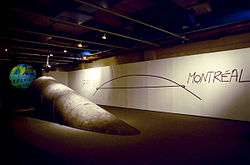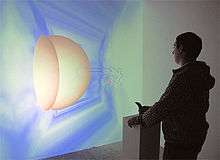Maurice Benayoun
| Maurice Benayoun | |
|---|---|
|
Maurice Benayoun in 2000 | |
| Born |
Maurice Benayoun 29 March 1957 Mascara, French Algeria |
| Education | Pantheon-Sorbonne_University |
| Known for | New Media Art |
| Notable work |
Quarxs (1991) Tunnel under the Atlantic (1995) World Skin, a Photo Safari in the Land of War (1997) |
| Awards |
Golden Nica Ars Electronica 1998, Chevalier des Arts et Lettres 2000, Siggraph 1991, Villa Medicis hors les murs, 1993, Imagina, 1993, International Monitor Awards... |
| Website | http://www.benayoun.com/ |
Maurice Benayoun (aka MoBen or 莫奔) (born 29 March 1957 in Mascara, Algeria) is a French pioneer new-media artist and theorist based in Paris and Hong Kong.[1] His work employs various media, including (and often combining) video, immersive virtual reality, the Web, wireless technology, performance, large-scale urban art installations and interactive exhibitions.
Biography
Born in Mascara, Algeria in March 1957, he moved to France in 1958. Graduating in Fine Arts (Pantheon-Sorbonne University) in the early 1980s, Benayoun directed video installations and short videos about contemporary artists, including Daniel Buren, Jean Tinguely, Sol LeWitt and Martial Raysse. In 1987 he co-founded Z-A, a computer graphics and Virtual Reality private lab. Between 1990 and 1993, Benayoun collaborated with Belgian graphic novelist François Schuiten on Quarxs, a computer graphics world that explores variant worlds with alternate physical laws.[2] In 1993, he received the Villa Medicis Hors Les Murs for his Art After Museum project, a virtual reality contemporary art collection.
After 1994 Benayoun was involved with more virtual-reality and interactive-art installations. One of these was described by Jean-Paul Fargier in Le Monde (1994) as "the first Metaphysical Video Game". One important work from this period includes The Tunnel under the Atlantic, finished in 1995. This was a tele-virtual project linking the Pompidou Center in Paris and the Museum of Contemporary Art in Montreal.[3] More than a technical performance, as the first intercontinental virtual reality artwork (called "televirtuality", Philippe Quéau, 1994), this installation was one-of-a-kind example of what Maurice Benayoun calls architecture of communication, as another way to explore limits of communication, after Hole in Space by Kit Galloway and Sherrie Rabinovitz. The Tunnel under the Atlantic introduces the concept of dynamic semantic shared space.
In 1997 he creates with Jean-Baptiste Barrière World Skin, a Photo Safari in the Land of War, an immersive installation, often mentioned as a reference in virtual art, which was awarded with the Golden Nica, Ars Electronica 1998.

The Navigation Room (1997) and The Membrane (2001) were created for the Cité des Sciences de la Villette. The Navigation Room presented, through an innovative interface, highly personalized visits and content, ending with a web page dedicated to each visitor. The Membrane (2001) — the core of the exhibition Man Transformed — was a large surface breathing and feeling the presence of the visitors. The Panoramic Tables for the Planet of Visions pavilion for Hanover EXPO2000, directed by François Schuiten, was an innovative application of augmented reality. In 2006, together with the architect Christophe Girault, they created the new permanent exhibition inside the Arc de Triomphe, Paris, opening in February 2007.
Benayoun conceived and directed the exhibition Cosmopolis, Overwriting the City (2005), a giant art and science immersive installation presented for French Year in China in Shanghai, Beijing, Chengdu and CongQing. In 2008, NeORIZON, a large scale urban installation in Shanghai, converted people into flash codes then becoming the city itself. Initiated in 2005, the series of works, Mechanics of Emotions presents Internet as the world nerve system and world emotions as a possible material for the new metaphoric model of economy.
In 2008 Maurice Benayoun submitted his blog, The Dump, a dump of undone art projects, as a doctorate thesis entitled: Artistic Intentions at Work, Hypothesis for Committing Art at Université Paris 1, la Sorbonne. The Phd received the "mention très honorable avec felicitations du jury" (First-Class Honors with Distinction).
To extend his vision of Urban Media Art, Maurice Benayoun launched in 2014, as a curator, Open Sky Project, allowing artists (Open Sky Gallery), and students (Open Sky Campus) to conceive and present works for one of largest screen in the world, the ICC media façade (70 000m2). This program offered more than 100 artists and students, the opportunity to exhibit their work in the public space. The ICC media façade represent about half the surface of the Hong Skyline video displays.
As a theorist, Maurice Benayoun coined the concepts of Critical Fusion, as "the fusion of fiction and reality to decipher the world" and Extended Relativity, a model from physics to understand the process of subjective data mining and urban navigation . He considered his recent works as a form of Open Media Art, paraphrasing Jon Ippolito, not limited to the traditional forms, media and economic schemes of art.
From 1984 to 2010 he was assistant professor at Paris 1 university, Pantheon-Sorbonne, where he was co-founder and art director of the CITU research center (Création Interactive Transdisciplinaire Universitaire) together with Paris 8 University. CiTu is dedicated to research and creation (R&C) in the emerging forms of art. In 2010 he became associate professor at Paris 8 university, where he founded (2011) and heads H2H Lab (the Human to Human Lab), a cluster of public and private labs envisioning art as an advanced form of human mediations. In August 2012, he becomes full Professor in the School of Creative Media of City University of Hong Kong where he is chair of the School of Graduate Studies and PhD coordinator.
Awards


- Prix Ars Electronica Visionary Pioneer of Media Art (nomination), 2014
- Absolut Think Tank Award, Athens, June 2012
- SACD Award, Interactive Arts, Paris, June 2009
- Qwartz, digital art, Paris, April 2009
- e-Toile d'Or, Net Art, Paris, January 2005
- Best multimedia project, Grotte Chauvet, France 2001
- Winner, Architecture competition with Jean Nouvel, Subway Station Franklin Roosevelt, Paris 2000
- Golden Nica (first prize), interactive art category, Ars Electronica Festival, Linz, Austria, 1998
- Second prize, Images du Futur '96, category opens titles, Montreal 1996
- Second prize Pixel INA, Opens Titles Category, Imagina 1996, Monte Carlo, February 1996
- Finalist Best Achievement, International Monitor Awards, Opens/closes category, Los Angeles, oct. 1995.
- Honorary Mention, Ars Electronica Festival, Linz, Austria, April 1995
- JOSE ABEL Prize, Best European animation film, Cinanima, Animation Film Festival of Espinho, Portugal, Oct. 1994
- Silver Trophy, Espace Creation, F.A.U.S.T., Toulouse, Novembre 1994
- Distinction (2nd prize), Ars Electronica Festival, Linz, Austria, June 1994
- 3rd Prize, fiction category, Imagina ’94, Monte Carlo, February 1994
- Best Electronic Special Effects, International Monitor Awards, Los Angeles, 1993
- Best Video Paint Design, International Monitor Award, Los Angeles 1993
- Nomination, Best Computer Animation, International Monitor Awards, Los Angeles 93
- First Prize Pixel INA, Opens Title category Imagina ’93, Monte Carlo, February 1993
- 3rd Prize, FICTION category Imagina ’94, Monte Carlo, February 1993
- First Prize, Third Dimension Award, SCAM, Paris, November 1991
- Best Script Award, Paris Cité 1991, Paris, October 1991
- Honorary Mention, Ars Electronica Festival, Linz, Austria, September 1991
- 1st Prize, Artistic Animation category, Truevision competition, SIGGRAPH, Las Vegas, 1991
- Image fixe prize, Paris Cité, Paris, France, 1990
- 1st Prize Communication Image, Tech Image competition, Paris, 1990
Selected works

- Big Questions : Is God Flat? (1994)
- Is the Devil Curved? (VR installation, 1995)
- And what about me? (Internet participative works, 1996-7)
- World Skin, a photo safari in the Land of War (1997)-Golden Nica, Ars Electronica Festival 1998
- Crossing Talks, Communication Rafting (Virtual Reality Internet installation, 1999)
- Art Impact, collective Retinal Memory (interactive installation, 2000)
- Labylogue (televirtual interactive installation, 2000)
- So.So.So., Somebody, Somewhere, Some Time (interactive installation, 2002)
- Watch Out (urban installation, 2004)
- Cosmopolis, Overwritting the City (Giant interactive installation, 2005)
- Mechanics of Emotions (series of works, 2005- )
- NeORIZON (urban interactive installation, 2008)
- Still Moving (interactive sculpture, 2008)
- The Dump (blog, 2006- )
- Last Life (online game, 2010)
- Emotion Forecast (Internet, urban screens, 2010)
- Dildomatic opera (music instrument, 2011)
- White Cube, The spirit of Contemporary Art (perfume, 2011)
- Sans Armes Citoyens (Internet collaborative work, 2011)
- Occupy Wall Screens (Urban screen, Internet real time video, 2012)
- Osmotic World (Interactive installation, exhibition, Athens, 2012)
- Tunnels around the World (Telematic installation, Seoul, San Jose, Hong Kong, Montreal 2012)
- E-SCAPE TODAY! (Urban screen, Internet, Seoul Square, Seoul, 2012)
- Color Shifts (Video loop, Show Of, Paris, 2013)
- Emotion Winds (Urban screen, Internet, Media Fest, Mumbai, 2014)
- Colors Tunnel (VR, Internet, video, Osage Gallery, HK, 2016)
- Borders Tunnel (VR, Internet, video, Osage Gallery, HK, 2016)
- Brain Factory Prototype (EEG, VR, 3D Printing, Art Center Nabi, Seoul, South Korea, 2016)
References
- ↑ Paul Catanese, Director's Third Dimension: Fundamentals of 3d Programming in Director 8.5, Sams Publishing, 2001, p314. ISBN 0-672-32228-5
- ↑ Stephen Wilson, Information Arts: Intersections of Art, Science, and Technology, MIT Press, 2002, p705. ISBN 0-262-73158-4
- ↑ Lars Qvortrupp, Virtual Space: Spatiality in Virtual Inhabited 3d Worlds, Springer, 2002, p222. ISBN 1-85233-516-5
Bibliography
- Maurice Benayoun, The Dump, 207 Hypotheses for Committing Art, bilingual (English/French) Fyp éditions, France, July 2011, ISBN 978-2-916571-64-5
- Timothy Murray, Derrick de Kerckhove, Oliver Grau, Kristine Stiles, Jean-Baptiste Barrière, Dominique Moulon, Jean-Pierre Balpe, Maurice Benayoun Open Art, Nouvelles éditions Scala, 2011, French version, ISBN 978-2-35988-046-5
- Sara and Tom Pendergast, Contemporary Artists St James Press, 2001, pp. 155–158, ISBN 1-55862-407-4
- Peter Weibel, Jeffrey Shaw, Future Cinema, MIT Press 2003, pp. 472,572-581, ISBN 0-262-69286-4
- Oliver Grau, Virtual Art, from Illusion to Immersion, MIT Press 2004, pp. 237–240, ISBN 0-262-57223-0,
- Frank Popper, From Technology to Virtual Art, MIT Press 2005, pp. 201–205, ISBN 0-262-16230-X
- Derrick de Kerckhove, The Architecture of Intelligence, Birkhäuser 2005, pp. 40,48,51,73, ISBN 3-7643-6451-3
- Gerfried Stocker and Christine Schöpf, Flesh Factor, Ars Electronica Festival 1997, Verlag Springer 1997, pp. 312–315
- Fred Forest Art et Internet, Editions Cercle D'Art / Imaginaire Mode d'Emploi, pp. 61 – 63
- Christine Buci-Glucksmann, "L’art à l’époque virtuel", in Frontières esthétiques de l’art, Arts 8, Paris: L’Harmattan, 2004
- Dominique Moulon Moulon.net, Conférence Report: Media Art in France, Un Point d'Actu, L'Art Numerique, p. 123
- Barbara Robertson CGW.com, Without Bounds in CGW volume 32 issue 4 April 2009
- Dominique Moulon, Art Contemporain, Nouveaux Médias, Nouvelles éditions Scala, Paris 2011, ISBN 978-2-35988-038-0
